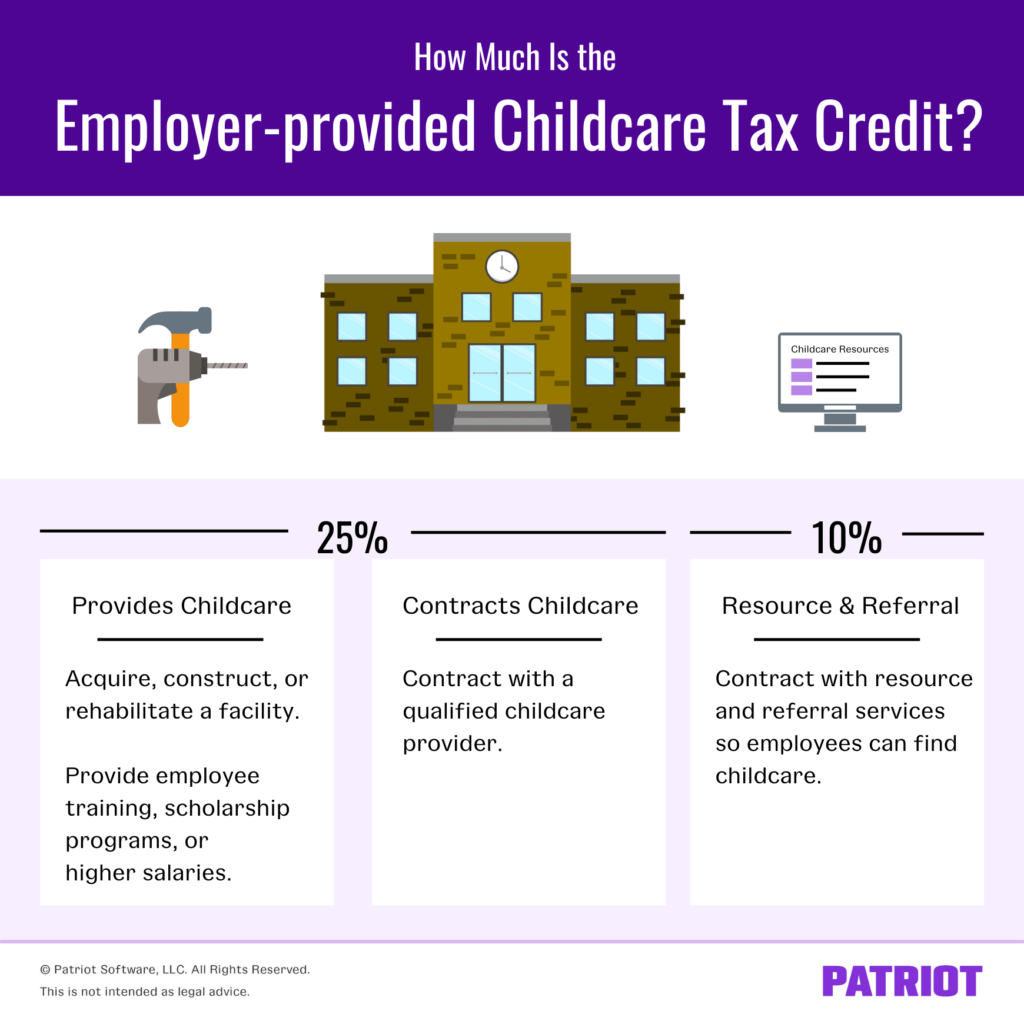The employer-provided childcare tax credit has existed for over 20 years to help employers secure affordable childcare for their employees. The only problem is, no one seems to know about it. It may be America’s best-kept secret for your employees with children.
In 2020, only 11% of employees had access to employer-provided childcare assistance. And in 2022, only 10% of employees have access to employer-provided childcare assistance. These aren’t just statistics; lack of adequate and affordable childcare changes the lives of your employees.
Think of it this way: In the U.S., anywhere from 20% to 35% of working mothers who give birth never return to their previous job. That’s a large loss of knowledge and skill. But thanks to the employer-provided childcare tax credit, employers can help mitigate these losses for employees who want to return to the workforce.
Read on for an overview of employer-provided childcare, an explanation of the employer-provided childcare tax credit, and what employer childcare programs might best suit your business needs.
What is employer-provided childcare?
Employer-provided childcare is a benefit you can offer employees to help them pay for some or all of their childcare costs. You can directly or indirectly pay for these benefits, which can include:
Employer daycare assistance isn’t a one-size-fits-all benefit. What you choose depends on what you can afford and the needs of your employees.
Now that you know what employer-provided childcare is, let’s talk about the employer-provided childcare tax credit.

What is the employer-provided childcare tax credit?
Created in 2001, the Employer-Provided Childcare Tax Credit offers employers up to $150,000 per year to offset qualified childcare costs by either 25% or 10%. The amount of the tax credit depends on how you offer employer-provided childcare.
You can claim 25% of your expenses if you provide onsite childcare or contract with a qualified offsite childcare facility. There are three ways to do this:
- Your expenses help acquire, construct, rehabilitate, or expand any property used as a qualified childcare facility
- Expenses help provide training for employees, scholarship programs for children, or provide higher salaries for advanced childcare professionals
- You contract with a qualified childcare facility
You can claim 10% of expenses if you contract with a resource and referral service that helps employees find childcare.
The employer-provided childcare tax credit is a dollar-for-dollar tax credit. Meaning, that for every qualified dollar you spend up to a certain amount (e.g., 25%), you’ll receive a dollar credit. Keep in mind that there is a difference between a deduction and a credit. Credits directly reduce your total tax liability, while a deduction reduces your final taxable income within your marginal tax bracket. But when it comes to childcare expenses, you may be able to combine the credit and business expense deduction to save even more money.
A business may deduct expenses that are considered both ordinary and necessary. Ordinary, meaning the expense is common in your industry. And necessary, meaning the expense is helpful in your industry.
To learn more about combining the employer-provided childcare tax credit and business expense deductions, take a look at the Government Accountability Office’s guide.
How do I claim this credit?
To claim this business credit, employers must fill out Form 8882 and attach it to Form 3800. Attach both of these forms to your business tax return (e.g., Schedule C, Form 1065 and Schedule K-1, Form 1120, or Form 1120-S).
When filling out Form 8882, make sure that:
- You claim the credit within three years from the due date of your return
- You’re filling out the right form. If your only source of this credit is from pass-through entities (e.g., partnerships, S corporations, estates, or trusts), you do not need to fill out Form 8882. Instead, report this credit directly on Form 3800
Keep in mind that you may have to recapture part of this credit. Recapture of credit will occur 10 years after your childcare facility opens if the facility closes or ownership changes hands. You can avoid recapture if the new owner agrees, in writing, to cover the liability.
Employees and employer-provided childcare
Employees can also save with this benefit. You can provide up to $5,000 in childcare assistance to each eligible employee and exclude it from the taxable wages reported on their Form W-2.
How does this affect employee taxes?
Employer-provided childcare is considered a fringe benefit. You may exclude these expenses from an employee’s taxable income if the benefit is something you offer to all eligible employees. You can’t include one group of employees and not another (e.g., higher-paid employees over those who are paid less). The tax exclusion reduces an employee’s overall tax burden.
It’s the employee’s responsibility to declare the benefit of workplace-funded childcare on their individual tax return. Your employee should claim their children as dependents and claim that childcare is necessary to properly perform their duties at work.
If the employee’s expenses are greater than the $5,000 exclusion limit, they may be able to claim the child and dependent care credit, as long as the expenses claimed are different.
So, what should I offer my employees?
Most employers have ignored the employer-provided childcare tax credit. But, there are plenty of reasons to claim it. Let’s take a look at your options when it comes to finding adequate childcare for your employees.
Find out the benefits of:
- Offering an onsite childcare facility
- Contracting with an offsite child-care provider
- Contracting with a resource and referral service
Reasons to have an onsite childcare facility
Providing an onsite childcare facility might not seem possible for small business owners. Sure, large companies can spend a million dollars per year, but this might not be in your budget. Luckily, the 25% credit isn’t the only benefit of having an onsite childcare facility.
Let’s use Patagonia’s onsite childcare facility as an example. Patagonia’s CEO pointed out these three benefits:
- Close to 91% of costs are recovered because of increased retention, tax benefits (e.g., the employer-provided childcare tax credit), and employee engagement.
- Their onsite childcare program has helped foster a trusting workplace culture.
- Because parents don’t have to spend their time caring for their children, they can continue to be integral to the company’s success.
Patagonia isn’t the only company that offers onsite childcare. Companies like Disney, Home Depot, and Proctor & Gamble also offer this benefit.
Reasons to contract an offsite childcare provider
Your workforce may come from a single region to work. For example, they live in a few different, surrounding suburbs and drive to your headquarters in the city. If this is the case, an offsite childcare provider may be exactly what you and your employees need. And don’t forget, you get a 25% credit on the money spent to make offsite childcare possible.
When shopping around for an offsite childcare provider, you should keep in mind:
- How close the childcare provider is to the office. If childcare is close by and easy to get to, this will count as a perk by itself. Promise.
- What the childcare provider offers children. You don’t have to look for the most expensive place possible. But remember, happy kids = happy parents = happy employees.
- The cost of the childcare provider (monthly and yearly fees). You know how much you can afford, so make sure you get the most for your dollar.
- How many employees with children you have on average. While this may be hard, if not impossible, to know, just think about it this way—you should work with a place that is big enough and properly staffed to handle your employees’ children. Make sure the childcare provider can meet your needs.
If your workforce is remote, contracting with a resource and referral service provider may be best.
Reasons to contract a resource and referral provider
If you have remote workers, they’ll need childcare just like everyone else, but both onsite and offsite childcare options may be off the table. So whether you have remote or in-office employees, you may opt to work with a resource and referral provider to help employees find childcare providers in their area. Plus, doing so gives you a 10% credit on expenses.
Nonprofits like Child Care Aware of America can help find local childcare providers. Direct your employees to national or regional resource and referral providers so they can find exactly what they need.
This is not intended as legal advice; for more information, please click here.



